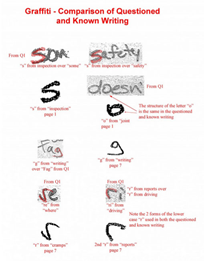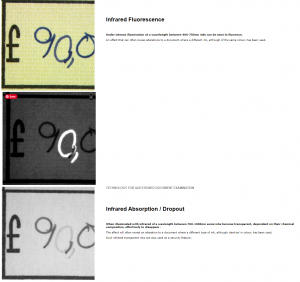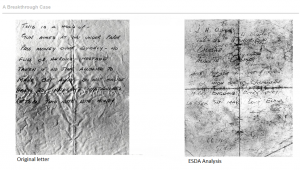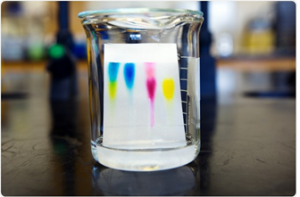Handwriting and Documents in Forensic Analysis

Someone forged a will. A staple of detective fiction, but how can anyone tell? We use Forensic Document Analysis to question the difference between authentic and non-authentic documents.
What is classified as a Document for forensic analysis?

Image 1: Analysis of Graffiti (Q9 consulting)
In his 2015 article, Mark Songer defines a document as ‘any material bearing marks, signs or symbols intended to convey a message or meaning to someone.’ (Songer, 2015)
That sounds like it includes a lot of things. Obviously, it means something written down on paper. How about graffiti?(Q9 Consulting). Is that a document? Or a tattoo? (Sundburg, 2017). The answer to these questions is ‘yes’. Forensic examiners advise on all of these.
What is a Questioned Document?
When doubt is raised about the validity or origin of a document, involved in a criminal or civil court case, this is a ‘Question Document’(NFSTC, 2013). Several reasons exist why a court needs scrutiny into the accuracy of an article presented to them (Seigel, 2020).
Forgery of a will, as mentioned above, is only one reason to call in the document examiners. Sometimes the police want to know who wrote a report. People can alter original writing for fraud, make threats, or write blackmail notes. All these things are considered when deciding whether to order a closer look at a record (Songer, 2015).
Handwriting analysis
The first option in examining a suspected item is handwriting analysis. This choice is used to confirm or learn who wrote a ‘document’. To do this a handwriting analyst can be hired. However, comparing handwriting requires a large number of controls.
Case study
A foreman a worksite wanted to know who was writing graffiti on the site walls, so he consulted a handwriting expert who put together the table, shown in image 1. But matching a few discrete characteristics cannot prove a match, so the case remained unsolved (Q9 Consulting).
Handwriting experts make claims about how handwriting analysis shows personality traits or whether the writer was under duress. Scientific validation has not yet been awarded to this sort of examination, but forensics experts are correct more times than most people (Songer, 2015). Unfortunately, no regulation of handwriting experts is in place and the investigator makes a subjective decision (Seigel, 2020).
Hidden Writing
The next thing to consider when studying a document, is whether the writing has been changed. When altering original documents for any purpose, there are two types of pen strokes used. One is where additional lines are added. As with hunting for specks of blood, (see article on blood here) looking at the situation in a different way shows up things that cannot be seen under normal conditions. In image 2, the uppermost picture shows £90,000. Yet, when looked at under alternative light sources the ‘0’ of the ‘90’ glows or vanishes.

Image 2: Alternative light sources reveal an altered document. (Foster+Freeman, Absorption and Fluorescence)
The different light sources are provided by a Visual Spectral Comparator (VSC) allows the operator to take and new perspective on the document. Depending on the light source, Infrared, Ultraviolet, or visible, the inks can glow as seen in the middle picture of Image 2 (Foster+Freeman, Fluorescence). Or the ink can absorb light and vanish as shown in the third picture of image 2 (Foster+Freeman, Absorption).
The second type of pen stroke is where letters and numbers are hidden by scratching over with another pen or they can be removed entirely. The alternative light sources of a VSC, allow the user to see through to the hidden pen strokes below.
Analyzing Invisible Writing
Not only can pen strokes be added, they can also press through the paper. Our fictional detectives are disappointed that the top sheet of paper at the scene of the crime has been ripped off. But wait! The person writing pressed hard and indentations from the message are visible. How would an expert recover them?
Another technique for discerning handwriting is Electrostatic Deposition Analysis (ESDA). Using static electricity, negatively charged toner collects in the indentations allowing the investigator to easily read the ‘invisible writing’.

Image 3: Invisible Writing is made visible with ESDA. (Foster+Freeman, 1978)
Case study
The first time ESDA evidence was accepted in a UK court was because of a bank robbery. The robber held the cashier at gunpoint and handed over a note. Unknown to the robber, the note contained indentations from a previous message, showing an address. ESDA exposed them, as shown in image 3. From that point, electrostatic analysis became vital in solving crimes (Foster+Freeman, 1978).
Types of Pen used for Handwriting
Different types of pens press lighter or harder on the paper beneath. Biro/ballpoint press hard through the paper and are the best for leaving indentations below. A Gel pen is next on pressure. Fountain pens and felt tip pens are the least likely to leave an impression on the paper below and are of little use in analyzing for invisible writing.
There’s a lot to be learned from Ink Analysis
The final method of distinguishing whether a document has been altered is by using Thin Layer Chromatography (TLC). TLC is another technique to determine if more than one pen wrote on a document. This procedure separates individual components of a mixture. Solvent dissolves the ink and the solvent/ink combination travels through a stationary phase, like silica gel. Larger molecules will fall out of the solvent first as it moves over the plate of the stationary phase. Smaller molecules follow the solvent front, until they too drop out of the solution.

Image 4: Pens from different manufacturers leave different patterns on the TLC Plate (Moore, 2020)
The inks from pens manufactured by different companies include different compositions of colors. When deposited on the stationary phase the leave distinctive patterns, like the ones in image 4(Moore, 2020).
How can this help with document analysis? Imagine a bill made out for $130.00. But the recipient thinks the bill should be for $40.00. If the ink from the ‘1’ and the ink from the ‘3’ or ‘0’ are extracted and form different patterns on a TLC plate then one of the numbers was added in a different pen.
Case study

Image 5: TLC plates. credit:V. Knipe
In image 5, of an actual ink analysis I performed on a receipt, you can see that the ink from the ‘O’ on the left hand plate is the same ink as the ‘1’ on the right hand plate and different from the ‘3’ on the right hand plate. In this instance, we can say that two different pens were used in writing the receipt.
Conclusion
In forensic document analysis, many techniques are available to determine whether a crime has taken place. To ascertain the validity of a document, reference samples are used to make an accurate comparison. With these controls, the forensic examiner authenticates a document by scrutinizing handwriting, displaying invisible and hidden pen marks, and differentiating between inks of pens from different manufacturers. All these methods help to solve crimes.
References
Foster+Freeman. Infrared Fluorence. http://www.fosterfreeman.com/tech/vsc-irfluorescence.html
Foster+Freeman. Infrared Absorption/ Dropout. http://www.fosterfreeman.com/tech/ir-absorption.html
Foster+Freeman. 1978, the original Foster+Freeman Instrument. https://www.fosterfreeman.com/product/qde-products/678-esda-history.html
Moore, S. (2020, March 20).Utilizing Thin Layer Chromatography in Ink Analysis. AZO Life Sciences. https://www.azolifesciences.com/article/Utilizing-Thin-Layer-Chromatography-in-Ink-Analysis.aspx
NFSTC (2013). A Simplified Guide to Forensic Document Examination – Common Terms. National Forensic Science and Technology Center. http://www.forensicsciencesimplified.org/docs/glossary.html
Q9 Consulting Inc. (2015-2019) Unsolved Graffiti Case. https://quality9.com/sample-exhibits/graffiti-case/
Siegel, J. A. (2020, June 1). forensic science. Encyclopedia Britannica. https://www.britannica.com/science/forensic-science
Songer, M. (2015, November 24). Forensic Document Analysis – Expert Overview. The Experts, Robson Forensic. https://www.robsonforensic.com/articles/forensic-document-examination-expert-witness
Sundberg, K. & Kjellman, U. (2017, November). The tattoo as a document. Journal of Documentation. 74. 10.1108/JD-03-2017-0043. https://www.researchgate.net/publication/320808154_The_tattoo_as_a_document







